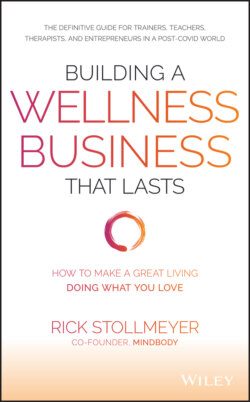Читать книгу Building a Wellness Business That Lasts - Rick Stollmeyer - Страница 12
The Seven Dimensions of Wellness
ОглавлениеWhat we are talking about with our great-grandmother in that imaginary conversation are the dimensions of wellness, and these are the central pursuits that drive most people alive today:
Physical Well-being: Keeping our bodies healthy and working optimally for as many years as possible
Emotional Well-being: Having the capacity to cope with the stresses of life
Social Well-being: Staying connected with our community, having the ability to maintain meaningful relationships, and finding love
Intellectual Well-being: Keeping our minds sharp and continually enhancing our wisdom and knowledge of the world
Environmental Well-being: Living in clean, nontoxic surroundings and protecting our planet
Occupational Well-being: Finding work that feeds our mind, body, and soul
Spiritual Well-being: Discovering the purpose and meaning of our lives
These are the Seven Dimensions of Wellness (shown in Figure 2.1), and our questions around them confused our great-grandmother, because she did not live in a world where she could spend much time thinking about them.
Unless your great-grandmother was among society's elites, she would have been as baffled by the wellness conversation as mine. This is because for nearly all of the first 200,000 years of existence, people simply didn't have the time or resources for wellness. The vast majority of them existed at the basic subsistence level, meaning their daily lives revolved around securing food, shelter, and physical safety—on staying alive and producing children.
Figure 2.1 The Seven Dimensions of Wellness
For those whose lives could be cut short by childbirth, war, disease, or famine, the causes seemed supernatural and outside of their control. All of us alive today are the descendants of those who survived those incredibly difficult millennia, and their suffering became our strength. Our adaptive minds, our instinct to create family units, our ability to form functioning societies, and our robust immune systems are all the result of hundreds of thousands of years of human evolution.
Despite those inherent strengths, until very recently average life expectancy was only a fraction of what it is today. The average life expectancy of a Roman citizen was 25 years. One thousand years later during the Middle Ages, life expectancy had reached only 33 years. A thousand years after that—around the time we are having that imaginary conversation with our great-grandmother—average life expectancy had reached only 55 years. Through all those eons of time the highest aspiration of nearly every human being was to survive long enough to produce successful offspring.
That is why people got married so young and why the marriage contract included the phrase “'til death do us part.” People needed to start producing children as teenagers in order to have a reasonable chance of raising those kids into adulthood before they died, and death wasn't that far away.
Who had the time to think about wellness in a life like that?
To understand the relevance of this to our lives today, we need to understand Maslow's hierarchy of needs.
